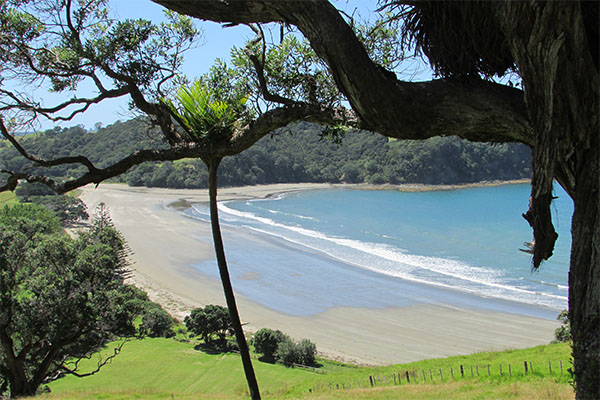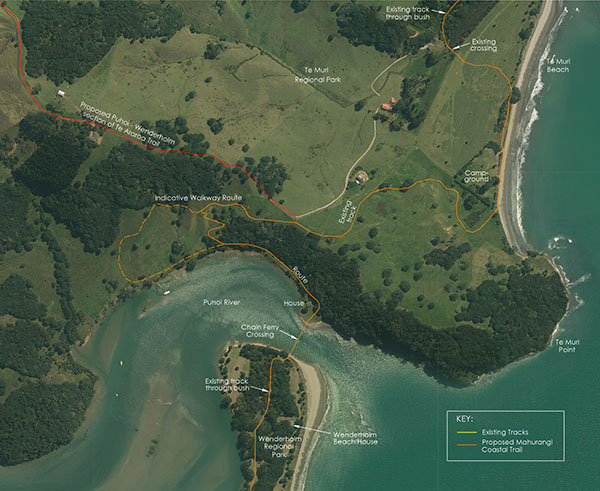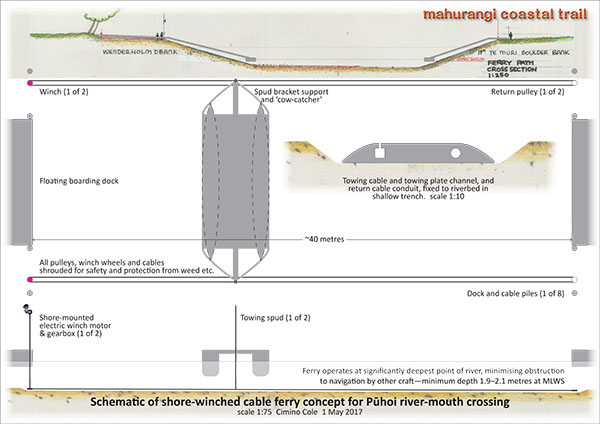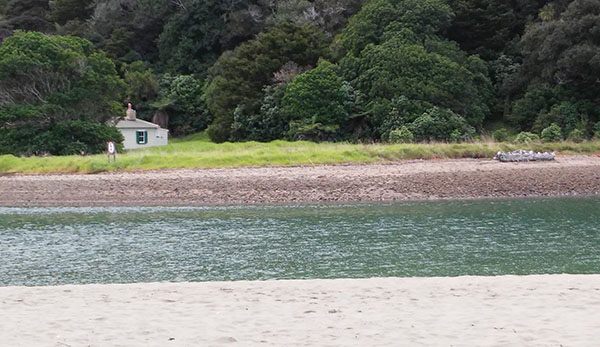Criteria for crossing Pūhoi River revisited

Ready and Waiting: Purchased 44 years ago, Te Muri, aside from a lucky few-thousand-a-year in-the-know adherents, remains largely unknown to its owners, the people of the Auckland region. The Mahurangi Coastal Trail will change all that, but in a much more sympathetic way than the road access with massed parking behind the beach, which has now been permanently ruled out, to the immense relief of those who treasurer its sense of splendid isolation. image Chris Eady
The principal objective of the Mahurangi Coastal Trail is to provide primary access to Te Muri.
Based on vehicle countsfor 2013–2014, Wenderholm Regional Park receives an estimated 225 362 visitors per year, and Mahurangi Regional Park 59 595. It is probable then, that once family-friendly walking access is available via Wenderholm, Te Muri will receive in the order of 50 000 visitors annually.
Daily patronage of the coastal trail is likely to vary vastly, but based on the patterns elsewhere, it is probable that there will be days when it was used by more than 1000 people. Patronage will be further concentrated in the Wenderholm to Te Muri direction during a ‘rush hour’ period, when a 40-passenger cable ferry might need to perform about 10 return trips per hour—just possible if efficiently organised.
There are, of course, numerous options for accessing Te Muri. The original plan was for a scenic road to be built between Mahurangi West and Wenderholm, connecting all the various regional parkland purchases, including coastal Te Muri, in 1973. But by the time the road access was scheduled to be provided, in 1987, attitudes had changed regarding the desirability opening up every last scenic corner to the car. Plans to cross the Pūhoi were scrapped, and access to Te Muri would only be from Mahurangi West. But even this was a concrete road bridge too far by the then Auckland Regional Authority. Mahurangi West locals, who, thanks to a kind-spirited regional parks farm manager, had been allowed foot access to Te Muri Beach, considerably ahead of the park’s opening.
The sense of splendid isolation that even ten minutes of walking could buy, when the destination was car free, had been a revelation to those who learnt, word-of-mouth, about Te Muri. So when geotechnical work began for the concrete road bridge to be built across Te Muri Estuary, the community was instantly united in opposition. But rather than simply oppose, a constructive alternative was proposed—for Te Muri to be developed for walking access. A compelling, visually attractive document was produced with the pro-bono help of strongly supportive professionals, and the then Citizens Advisory Group of the regional authority was hooked. The road to Te Muri, the estuary road bridge abomination, and parking for 2000 cars, was scuttled.

Ferry Hideaway: Unless headed for Te Muri, few visitors to Wenderholm would be aware of the cable ferry operating silently at the river mouth. Those who did wander into their vicinity, are likely to be intrigued and attracted to the facing jetties, rather than repulsed by them. Admittedly, fishers would be obliged to relinquish a 20-metre stretch of the riverbank, but most of those would probably be more than happy with the trade-off—access to the currently mostly unfished northern side of the Pūhoi River, via the ferry. map Parallax Surveyors and Planners – Morphum Environmental
With the purchase of the 383-hectare farm behind Te Muri, in 2010, fresh plans were made for road access and massed car parking at the beach. But rather than the road crossing the Pūhoi Estuary, it was to follow the scenic ridge and render it useless as the obvious terrestrial route for Te Araroa, the national walkway—currently the majority of Te Araroa walkers are forced to struggle along the shoulder of State Highway 17the official route involves kayaking or otherwise navigating the Pūhoi River, which, aside from the cost, is out-going-tide-dependent, between Pūhoi and Wenderholmand presumably many don’t bother visiting Wenderholm at all, given that it then represents a detour. Desperate to head off yet another car-centric park, the first detailed proposal for the Mahurangi Coastal Trail were drawn up by the community. The process of convincing the park’s administrators of the merits of walking as the principal means of public access proved to be more prolonged and costly in the 2010s than in the 1980s, but on Valentine’s Day 2017, Te Muri officially became car-free forever.
While the Mahurangi Coastal Trail concept was crucial to the overwhelming public support for a car-free Te Muri, a key component, a 300-metre-long footbridge across the Pūhoi Estuary, found favour with neither council nor iwi—landscape and visual impact being the specific objection. The council’s suggested alternative, of a cable ferry was immediately embraced by the Mahurangi Coastal Trail Trust, which wholeheartedly agreed that it:
…could become a unique attraction in itself, without the need for large infrastructure crossing the river.
There are, of course, other ways to cross a river than footbridges or cable ferries. One of the more obvious options is a cable car—the 76-metre elevation of the ridgeline above the northern bank river mouth would have the cable clear of even the 24-metre wing of the current America’s Cup class of catamaran, should one decide to swing into the estuary of a tide. But whereas the landscape and visual impact of a cable ferry would be very localised, every park visitor, and passing vessel, would be acutely aware of a cable car, and its incongruity.
The criteria for a non-footbridge crossing was comprehensively explored by the Mahurangi Magazine more than six months ago, when it was determined that the prime criterion for a cable ferry operating across the Pūhoi river mouth is that its operation doesn’t appreciably impede navigation by other craft. This requirement all but baked in the need for any cable ferry to be a chain ferry—of the conventional cable ferry options, only those using chain cable have the characteristic of allowing other craft to pass close by without risk of fouling a cable.
In the instance of a Pūhoi river-mouth chain ferry, the necessity of minimally obstructing the narrow—50-metre wide at low-tide—navigable channel, the ferry should operate aligned to the current. This configuration could prove challenging in respect to maintaining the desired fore-and-aft alignment, including coping with wind influence, without requiring so little slack in the chains that they presented a propeller-fouling hazard. Additionally, it may prove necessary to adjust the chain length for tidal elevation, however, conceptually, this could be elegantly automated by harnessing the tidal rise and fall of one of the boarding pontoons.

Electric Shore-Powered Cable Ferry Concept: Given that there would be days during which the Pūhoi river mouth cable ferry would need to operate continuously, running it off electricity stored in batteries carried aboard the vessel would be wantonly inefficient—probably tripling the cost of energy delivered. By the elegantly simple expedient of siting the electric motors ashore, both capital and operating costs would be minimised. concept Mahurangi Magazine
A novel alternative is now being explored whereby, rather than the ferry winching itself along its twin cables, the winches are shore-mounted and the ferry is towed back and forth by two endless cables.
Given the considerable desirability of the ferry being electrically driven, siting the motors ashore and using shore power has the enormous benefit of dispensing with the considerable expense of operating sufficient battery storage for the ferry to run continuously, with or without rapid recharge during dwell time on the side of the river with shore power available.
It is envisaged that the ferry would attach to each of the driving cables via spudsvertical positioning poles. Used locally to position oyster barges that would be free to vertically to adjust to the tide height. This arrangement would also readily allow the ferry to be disengaged from its cables, to be moved for maintenance, or to a sheltered mooring in advance of potential extreme onshore weather. But most importantly, after the ability to run cleanly and cheaply on shore power, is that the towing system would allow for precise alignment of the ferry, which is highly desirable for passenger comfort en route, and when docking. Without close control of both bow and stern when underway, wind could well cause the ferry to twitch directionally; and close control of bow and stern would allow for smooth, impact-free docking.
The same control would also allow optimal angling of the ferry’s catamaran hulls to the current, to derive propulsive assistance from it. During a significant part of the tidal cycle, the current flow is greater than two knots, inward and outward. The average speed of the ferry might not need to be more than one knot. At that speed, the crossing would only take a minute—far more time would be taken up by passengers embarking and disembarking. In the earlier cable ferry exploration, a shallow-draft monohull was considered, with view to allowing passengers to embark and disembark via fold-down ramps, without shore infrastructure—at least until such time passenger volumes demanded it. But given the requirement for pontoons for other purposes, described below, a catamaran is a significantly more stable platform for ferrying passengers, particularly when disembarking, when much of the live weight can be concentrated at the ferry’s beam.
All submerged drive shafts, winch wheels, pulleys and cables would be shrouded or conduited to prevent debris—or errant swimmers—from jamming the mechanism. The towing cables would run within channels, with only the towing points protruding through a slot. The slots may need to be ‘closed’ with opposing rubber flaps to exclude the bulk of silt and sand that would wash over them at times. Further, pliable piston cups would probably be fitted to routinely pump such silt and sand from the towing channel. While all this may sound to be a substantial investment in riverbed infrastructure, the total travel required is only about 35 metres—the navigable width of the river at low tide, less the beam the pontoons and ferry. But nor would this be a navigational bottleneck—at the next channel marker downstream, the channel is half the width and depth.

Cottage Case in Point: Situated on the side of the Pūhoi River Mouth without ready access to mains power, the Pūhoi Cottage sits unused throughout winter on account of its reliance on solar power—a stretch in its winter-sun-shaded location. Attempting to run the cable ferry’s motors from solar-panel-generated battery-stored electricity would be a forlornly futile exercise. image Mahurangi Magazine
As mentioned, the earlier development of criteria for a non-footbridge crossing, it was assumed that the ferry might initially operate without the need for shore infrastructure such as jetties and floating pontoons. However, the absolute need for indigenous sand-binding plants to be nurtured on the sandspit foreshore, particularly at the river mouth, dictates that ferry-user foot traffic must be kept off the dune face. By channelling foot traffic along a jetty, and impeding direct pedestrian access to the dune area, the operation could be expected to have a strongly net positive impact on the local ecology. Meanwhile, park users walking the beach in the river mouth area, whether to access the cable ferry or for other reasons, would be catered for with two or three steps leading up and across the jetty, the deck of which would be built at the minimal practicable height.
Given the need to protect the critical indigenous flora, funnelling passengers onto the Mahurangi Coastal Trail, or sandspit perimeter walking route, without impacting the dunes, favours deployment of a pair of floating-dock jetties. This would also greatly facilitate embarkation and disembarkation, particularly if the deck levels of ferry and pontoon were aligned and locked during that phase. While these jetties would have some landscape and visual impact, it would be extremely localised, and the structures would be entirely congruous with their coastal setting.
During the management-plan-variation process, Auckland Council’s coastal engineer warned that the footbridge alternative then being considered could cost $10–20 million, and even a very basic structure, which an engineer had earlier proposed, was certain to spoil $1 million. It is a reasonable expectation that a cable ferry and its shore infrastructure could be established at a cost favourably comparable with the footbridge and cable car alternatives.
Until a ready means of accessing Te Muri is provided, the 383 hectares purchased for $15 million in 2010 will languish largely unused. The best current thinking of the Mahurangi Coastal Trail Trust is that Auckland Council’s suggestion of a cable ferry is the most sympathetic means of opening Te Muri to its owners.
The community can take pride in initiating the Mahurangi Coastal Trail, but also in its council officers for courageously suggesting an outside-the-square solution to crossing the Pūhoi River.
Longform criteria for non-footbridge crossing
Criteria for Mahurangi Coastal Trail
This hierarchy of criteria groups begins with for the Mahurangi Coastal Trail itself, which must:
- Be culturally embraced and environmentally sensitive
- Be reasonably adjacent to the coastline
- Be accessibility- and family-friendly
- Be available everyday
- Be traversable continuously during daylight hours (i.e. be all-tide)
- Be adaptable to sea-level rise
- Be economically sustainable.
High-level criteria for crossing
The Pūhoi River crossing must:
- Have a minimal landscape and visual impact
- Be an all-tide crossing
- Not impede navigation
- Be an affirming experience for coastal trail users.
Criteria for ferry crossing
Assuming crossing style is a ferry crossing, without ruling out the possibility, however unlikely, that a preferable alternative is identified, the ferry crossing must:
- Operate in all but heavy or extreme weather
- Not require dredging
Criteria for river-mouth ferry crossing
The previous criteria dictate a river-mouth ferry crossing, as this is the only point at which sand and mud banks don’t impede traverse. A river-mouth ferry crossing must:
- Have only low impact on geomorphology of vulnerable Wenderholm sandspit, including on the sand-binding plants, which are currently at risk from foot traffic (northern bank is geomorphically stable, being stone rather than sand)
- Present narrowest aspect to passing vessels (i.e. ferry-glide, rather than proceed at right angles to current)
- Dock without shore-crew assistance
Criteria for cable ferry
The preceding criteria dictate a cable ferry, as jet or propeller driven craft would significantly scour the Wenderholm sandspit. A cable ferry crossing must:
- Minimise cable interference to passing vessels, and vice versa
- Possess adequate directional control when underway
- Possess adequate directional control when paused partway across channel, such as to allow another vessel to pass ahead of the ferry
- Operate cleanly and quietly—for aesthetic and environmental imperatives
- Operate continuously (and if electric, not be delayed by charging requirements)
- Provide gap- and step-free deck-to-dock walking and wheelchair access
- xxx
Criteria for operation of cable ferry
Preceding criteria requires the experience of using the coastal trail be affirming and family-friendly. Operation of a chain ferry must:
- Be human-propelled, or supplemented, if possible, and as emergency propulsion
- When human-propelled, not pose risk to operators, such as through power being reversed to power crank handles.
- Be capable of being operated by one person, in an emergency.
Criteria for chain ferry prototype
The preceding criteria, and the lack information on a chain ferry in a closely comparable operating environment, suggests that prototyping is preferable to proceeding directly to building a chain ferry under survey, and thus at a cost considerably greater than for a ‘disposable’ vessel. A prototype chain ferry crossing must:
- Have alternate, chain-free, means of being propelled and manoeuvred
- Be capable of being operated operated without shore infrastructure
- Draw upon best available knowledge to inform design and operation
- Be able to be provided at minimal cost and/or have a use beyond the prototyping phase and/or be useful in providing an interim, donation-only, service.
